Arc Flash Labeling Requirements (2024)
Ensuring OSHA Arc Flash Compliance via NFPA 70E Standards
The Occupational Safety and Health Administration (OSHA) is an organization that provides workplace guidance about electrical safety-related work practices in the form of regulations, like 29 CFR 1910.333(a), which emphasizes the use of safety-related work practices to prevent electric shock and other injuries when working on or near energized equipment.
While OSHA has specified the above regulation, you may not know exactly how to put it into action. This is why the National Fire Protection Association (NFPA) is needed. Through their NFPA 70E Standard for Electrical Safety in the Workplace, you can comply with OSHA regulation 29 CFR 1910.333(a) (opens in a new tab). Their most current edition (2024) outlines 6 primary responsibilities facilities must meet:
- Training for employees
- Written safety program in place that is actionable
- Personal Protective Equipment (PPE) available for employees
- Insulated tools
- Arc flash hazard degree calculations
- Properly labeled equipment
Equipment Labeling for Arc Flash Compliance
Alerting personnel to electrical hazards is critical to safety. One of the best ways you can do this is visually through labels. Arc flash labels are a requirement listed in NFPA 70E Article 130.5.
Who is responsible for equipment labeling?
The owner of electrical equipment is responsible for the documentation, installation and maintenance of the marked label. So, if you rely on contractors to perform electrical work, it’s your responsibility to ensure these elements are implemented or updated. Make sure you’re using high-performance labels that can outlast their environment.
Shop Arc Flash LabelsWhat equipment requires an arc flash label?
According to NFPA 70E, labeling is required for any piece of electrical equipment that may need examination, adjustment, service or maintenance while energized. These labels communicate the electrical hazards an employee may be exposed to, including the potential for an arc flash incident.
Examples of where to put your arc flash labels to stay compliant
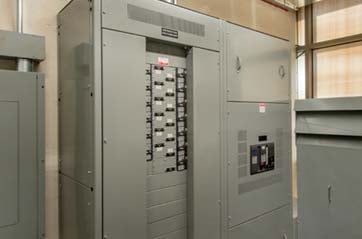
Switchboards
Label where un-terminated wires or cables needing superior abrasion and chemical resistance exist.
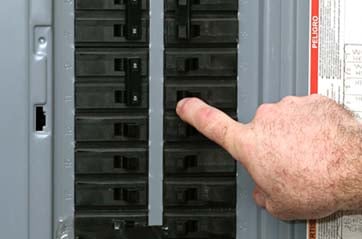
Panel Boards
Label where terminated or unterminated cables and wires that may be curved or become curved exist.
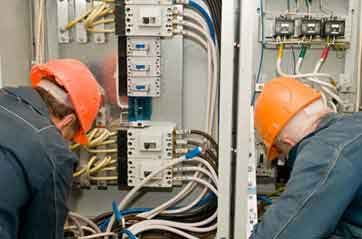
Industrial Control Panels
Label where terminated cables or wires that may need additional abrasion or chemical resistance exist.
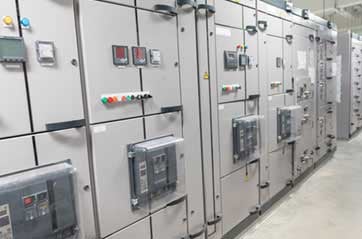
Motor Control Centers
Label where large amounts of data needs to be communicated in a small area, such as fiber optic cables.
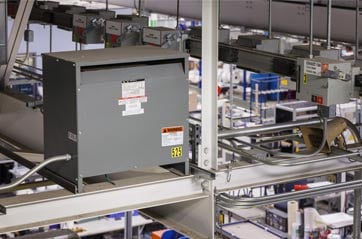
Transformers
Label where large amounts of voltage exist, either on the ground or mounted up high in a facility.
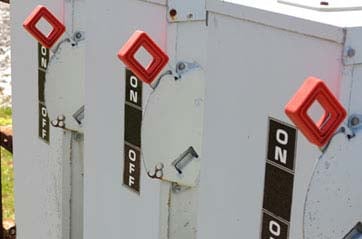
Disconnect Switches
Label where multi-conductor cables or bundled wires/cables exist.
Equipment Labeling
Old Label Versions. The recent update allows labels applied prior to the effective date of this edition of the standard to be acceptable if they complied with the requirements for equipment labeling in the standard in effect at the time the labels were applied (unless changes in electrical distribution system render the label inaccurate).
Document and Review. Document the method of calculating and the data to support the information for the label and review for accuracy at intervals not to exceed 5 years. Where the review of the data identifies a change that renders the label inaccurate, the label shall be updated.
The owner of the electrical equipment shall be responsible for the documentation, installation and maintenance of the marked label.
Shop Brady's Arc Flash Labels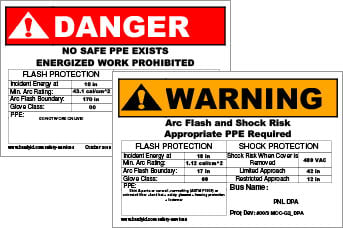
7 Elements of an Arc Flash Label
Now that you’re familiar with the equipment that needs labeling, here are the elements you will need to include in your arc flash labels.
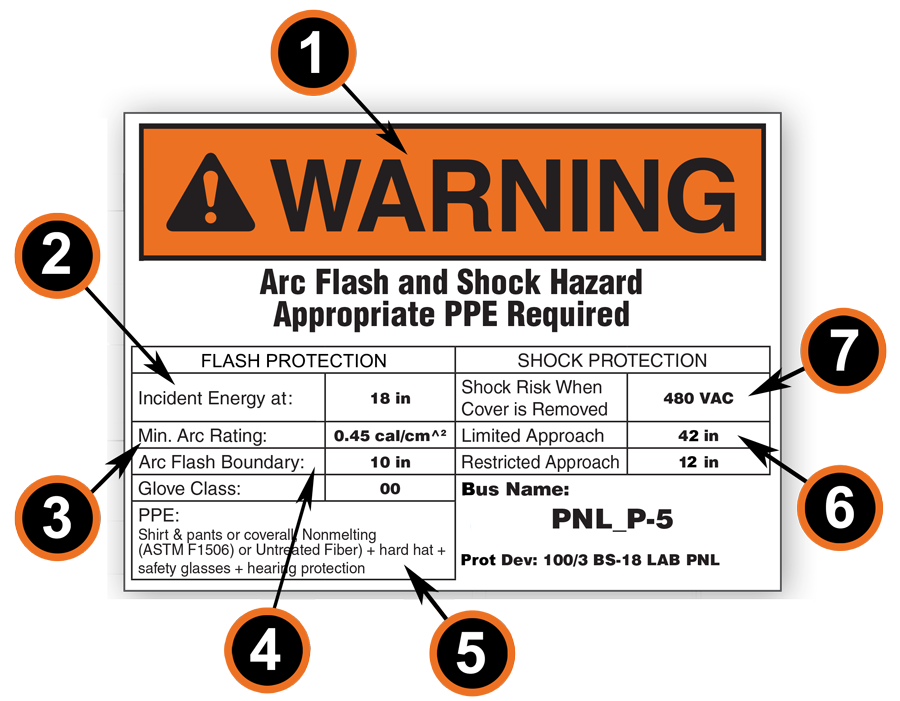
-
Danger or Warning header
A common guideline is to use the "Danger" header when the voltage is over 600 or when the incident energy is over 40 cal/cm2. If it is less than this threshold, an orange "Warning" header is typically used.
-
Incident Energy at is the corresponding working distance
The Institute of Electrical and Electronics Engineers (IEEE) defines this as "the dimension between the possible arc point and the head and body of the worker positioned in place to perform the assigned task."
-
Min. Arc Rating is the incident energy
A measurement in calories/cm2 or Joules/cm2 of thermal energy at a working distance from an arc fault.
-
Arc Flash Boundary
This is the shortest distance at which a person working at the time of an arc-flash may receive permanent injury (the onset of a second degree burn or worse) if not properly protected by flame-resistant (FR) clothing.
-
Personal Protective Equipment (PPE)
Each hazard risk category requires a different level of protection. Categories range from 1 to 4. Category "0" was removed in the NFPA 70E 2015 Changes.
-
Limited Approach and Restricted Approach fields are related Shock Hazard Approach Boundaries.
These boundaries are defined in more detail in our Arc Flash Workplace Safety Guide. The "prohibited approach" boundary was removed in the 2015 NFPA 70E edition.
-
Shock Risk When Cover is Removed
The voltage of the equipment.
Training Requirements
Retraining should occur every 3 years, and employees must also be retrained if their job duties change, or when procedures are not being followed (as observed by annual inspections or supervision).
Training should include:
- Specific hazards associated with electrical energy
- Special precautionary techniques and safety related work practices
- PPE, insulating and shielding materials, insulated tools and test equipment
- Emergency response and AED training
- Skills and techniques to distinguish energized parts determine nominal voltages
- Approach distances
- Decision making process and ability to perform job tasks
Training sessions must be documented and verified at least annually, and participants must be able to demonstrate knowledge. To help keep your workplace safe and compliant, Brady Safety offers a custom approach to Arc Flash Training.
Got gaps in your arc flash safety program?
Identify your arc flash safety needs quickly — use our Arc Flash Safety Checklist tool.
Arc Flash Safety Checklist ToolNFPA 70E 2024 update
The standard gets updated every three years. Here’s what’s new in 2024.
The NFPA 70E Standard for Electrical Safety in the Workplace is revised every three years by you (the public) and industry. In the 2024 edition, you’ll find proactive ways to stay safe when working with energized equipment and systems. It features:
- An increased emphasis on risk assessment and control
- More guidance on training and education requirements
- Better clarification on PPE usage in various settings
- A 2023 update determined that infrared thermography is now a requirement for annual inspections.
The 2024 edition also includes additions and reorganized sections. Some highlights include:
-
Labeling: An update was added in the 2024 edition to NFPA 70E Article 130.5(H): Equipment Labeling. In addition to labeling the arc flash boundary and voltage method of defining PPE requirements, you'll need to ensure labels are of sufficient durability for the environment involved.
-
Scope: Each article now has a scope, which caused some sections to be renumbered
-
Definitions: All are now located in Article 100
-
Terms: 'Electric' now appears before 'shock', and 'Leather' was deleted to permit other protector types
-
Emergency response plan: It’s now required in the job safety plan
-
A safe work condition: It was renumbered from 120.5 and 7 to 120.6 and they added the words "At each point of work".
-
Shock approach boundary tables: These are adjusted to correspond with OSHA 1910.269
-
Normal operation of electrical equipment: Equipment must be rated to handle available fault current.
-
Assessing the condition of maintenance: New section added: Informative Annex S – informational only
NFPA 70E 2021 Updates
Here’s what’s new in 2021.
The NFPA 70E standard was updated for 2021, including adding detail to term definitions, clarifying requirements and reorganizing information for a more logical progression. The most notable changes are:
- Extra emphasis on the employer's responsibility to create an electrically safe work condition
- Stressing that doing energized work with PPE should be a last resort.
Key updates to terms
- Electrically safe work condition: Note added to clarify that an electrically safe work condition is not a procedure, but a state where all hazardous electrical conductors or circuit parts to which a worker might be exposed are de-energized.
- Fault current: Note added to clarify that available fault current varies by location in the circuit.
- Shock hazard: Updated to indicate that parts must be exposed to be a hazard.
Other notable changes to NFPA 70E for 2021
- Calls out the importance of de-energizing as a requirement of an Electrical Safety Program. Programs now must include a policy on establishing an electrically safe work condition.
- Clarifies that the lockout or tagout program must be either part of the electrical safety program, or must reference the lockout or tagout program.
- Confirms that electrical safety is based on all equipment being used as intended by the manufacturer.
- Revises requirements of a lockout device to align with OSHA 1910.333(b)(2)(iii)(E).
- Includes new or revised tables for estimating the likelihood of occurrence of an arc flash incident and guidelines around rubber insulating gloves, tools and equipment.
- Clarifies language around the use of barriers or barricades.
- Adds new information on safety-related requirements for capacitors.
Looking for more details?
Download our Overview: NFPA 70E® 2021 changes (PDF opens in a new tab)
Other NFPA 70E Updates: 2018 | 2015
Further Reading: OSHA regulation 29 CFR 1910.333(a) (opens in a new tab)
Arc Flash Safety Services
Let our safety professionals guide you with assessments, audits, training and more.
Learn More